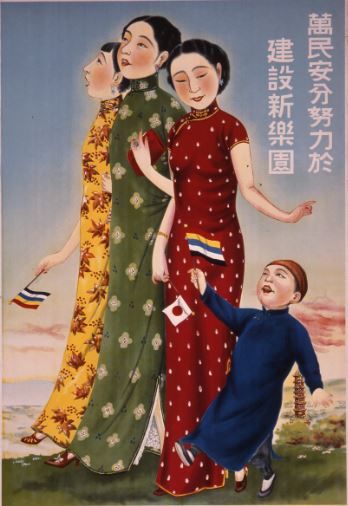Shaoqian Zhang
Professor, Oklahoma State University, Department of Art, Graphic Design and Art History
The Making of Harmony and War, from New Year Pictures to Propaganda Posters during China’s Second Sino-Japanese War
Abstract:
Historically, Sino-Japanese cultural exchanges were dominated by a China-oriented mentality. This relationship shifted abruptly in the late nineteenth century with Japan’s rapid westernization and industrialization, which coincided with the cultural and political implosion of the Qing Dynasty, and was further inverted as Japan became a world power and China struggled to reassemble itself. It was thus with a sense of justification that the Japanese advertised themselves as the legitimate protector of East Asian culture, and key Chinese cities under their occupation became a battleground for what Japan called the New Order in East Asia. Some Japanese and Chinese were able to agree on a working relationship under a new structure of political authority, and a number of propaganda posters were produced to reflect these negotiations. After 1938, the Chinese Guomindang also began to pay attention to propaganda art. Based on original archival research of primary historical documents and visual analysis of important icons in those propaganda images, this article examines the subsequent war of propaganda prints between the Guomindang and the Japanese militarists during the 1930s and 1940s, and demonstrates how the Chinese were able to utilize a variety of signs, symbols and art techniques to create their own propaganda prints in the effort to break from New Order in East Asia.
_____________________________________________
Prof. Shaoqian Zhang specializes in East Asian art and architecture, and teaches courses in Chinese and Japanese art and architectural history at OSU. She received her BA in traditional Chinese architecture from Beijing University, and MA and PhD in art history from Northwestern University. She joined the OSU faculty in 2011.
Zhang’s research and teaching interests focus on the history of Chinese printmaking and propaganda art, particularly in relation to representations of modernity, party-state and body politics. Her dissertation, “Visualizing the New Republic: Pictorial Construction of the Modern Chinese Citizen (1895-49),” examines how consistent, ubiquitous themes in traditional Chinese New Year prints evolved into a modern political propaganda language. She has published “The Supremacy of Modern Time: How Shanghai Calendars Reshaped the Image of China” in Modern Art Asia (Mar. 2011), “New Configuration of Gendered Development in Chinese Modern Movies (1930-40),” in Parnassus (March 2008) and “Comparative Analyses of Capital Cities in the Tang and Song Dynasties,” in Kaogu yu wenwu [Archeology and Culture Relics] (2002: Supplementary Issue).
Her current project centers on the war of propaganda art between China and Japan during World War II. She is intrigued by the historical interactions between China and Japan through the spread of print technologies, graphic design and modernization. Her other interests include the relationship between architectural representation and nationalism in China and Japan during the 1920s – 30s, the idea and visual embodiment of “Pan-Asianness” and post-1949 Chinese landscape paintings.
Zhang has been the recipient of research and writing grants, including Northwestern University Dissertation Year Fellowship, Mickenberg/Sosin Graduate Student Fellowship and Barbara Smith Shanley Graduate Travel Fellowship. Before coming to OSU, she worked as a visiting instructor at the University of Kentucky (2010-11) and Denison University (2009-10).
Friday, Nov 7th, 4:30-6:30pm, CWAC 156
Persons with disability who may need assistance, please contact Tingting Xu tingtingxu@uchicago.edu.
